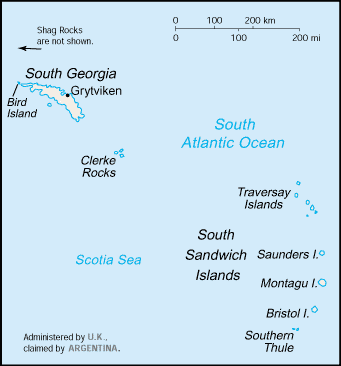|
|
Legend:
 Definition
Definition
 Field Listing
Field Listing
|
Background:
|


The islands lie approximately 1,000 km east of the Falkland Islands and have been under British administration since 1908 except for a brief period in 1982 when Argentina occupied them. Grytviken, on South Georgia, was a 19th and early 20th century whaling station. The famed explorer Ernest SHACKLETON stopped there in 1914 en route to his ill-fated attempt to cross Antarctica on foot. He returned some 20 months later with a few companions in a small boat and arranged a successful rescue for the rest of his crew, stranded off the Antarctic Peninsula. He died in 1922 on a subsequent expedition and is buried in Grytviken. Today, the station houses scientists from the British Antarctic Survey. The islands have large bird and seal populations and, recognizing the importance of preserving the marine stocks in adjacent waters, the UK, in 1993, extended the exclusive fishing zone from 12 NM to 200 NM around each island.
|
| |
Geography |
South Georgia and the South Sandwich Islands |
|
|
Location:
|


Southern South America, islands in the South Atlantic Ocean, east of the tip of South America
|
|
Geographic coordinates:
|


54 30 S, 37 00 W
|
|
Map references:
|


Antarctic Region
|
|
Area:
|


total: 3,903 sq km
note: includes Shag Rocks, Black Rock, Clerke Rocks, South Georgia Island, Bird Island, and the South Sandwich Islands, which consist of some nine islands
water: 0 sq km
land: 3,903 sq km
|
|
Area - comparative:
|


slightly larger than Rhode Island
|
|
Land boundaries:
|


0 km
|
|
Coastline:
|


NA km
|
|
Maritime claims:
|


exclusive fishing zone: 200 NM
territorial sea: 12 NM
|
|
Climate:
|


variable, with mostly westerly winds throughout the year interspersed with periods of calm; nearly all precipitation falls as snow
|
|
Terrain:
|


most of the islands, rising steeply from the sea, are rugged and mountainous; South Georgia is largely barren and has steep, glacier-covered mountains; the South Sandwich Islands are of volcanic origin with some active volcanoes
|
|
Elevation extremes:
|


lowest point: Atlantic Ocean 0 m
highest point: Mount Paget (South Georgia) 2,934 m
|
|
Natural resources:
|


fish
|
|
Land use:
|


arable land: 0%
permanent crops: 0%
other: 100% (largely covered by permanent ice and snow with some sparse vegetation consisting of grass, moss, and lichen) (1998 est.)
|
|
Irrigated land:
|


0 sq km (1998 est.)
|
|
Natural hazards:
|


the South Sandwich Islands have prevailing weather conditions that generally make them difficult to approach by ship; they are also subject to active volcanism
|
|
Environment - current issues:
|


NA
|
|
Geography - note:
|


the north coast of South Georgia has several large bays, which provide good anchorage; reindeer, introduced early in the 21st century, live on South Georgia
|
| |
People |
South Georgia and the South Sandwich Islands |
|
| |
Government |
South Georgia and the South Sandwich Islands |
|
|
Country name:
|


conventional long form: South Georgia and the South Sandwich Islands
conventional short form: none
|
|
Dependency status:
|


overseas territory of the UK, also claimed by Argentina; administered from the Falkland Islands by a commissioner, who is concurrently governor of the Falkland Islands, representing Queen ELIZABETH II; Grytviken, formerly a whaling station on South Georgia, is a scientific base
|
|
National holiday:
|


Liberation Day, 14 June (1982)
|
|
Constitution:
|


adopted 3 October 1985
|
|
Legal system:
|


the laws of the UK, where applicable, apply; the senior magistrate from the Falkland Islands presides over the Magistrates Court
|
|
Diplomatic representation in the US:
|


none (overseas territory of the UK, also claimed by Argentina)
|
|
Diplomatic representation from the US:
|


none (overseas territory of the UK, also claimed by Argentina)
|
|
Flag description:
|


the flag of the UK is used
|
| |
Economy |
South Georgia and the South Sandwich Islands |
|
| |
Military |
South Georgia and the South Sandwich Islands |
|
|
Military - note:
|


defense is the responsibility of the UK
|
|
Disputes - international:
|


South Georgia and the South Sandwich Islands occupied briefly by Argentina in 1982; islands continue to be claimed by Argentina
|
This page was last updated on 1 January 2002
|




